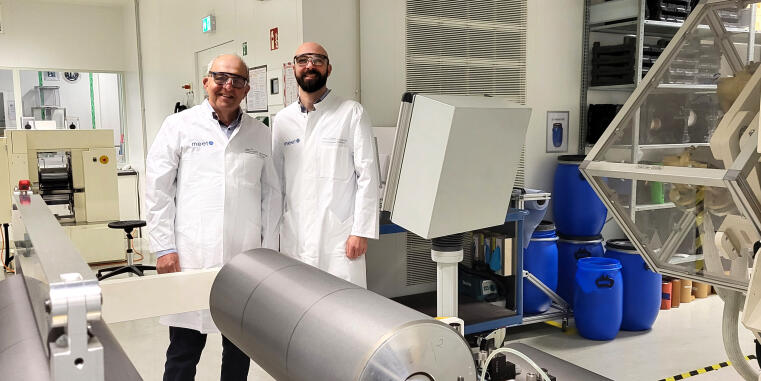“Battery Line Runs like Clockwork”
MEET Battery Research Center at the University of Münster has its own battery pilot line for ten years now. Consisting of several devices and plants, it enables the autonomous production of lithium-ion batteries in the in-house multi-layer pouch design (11966) with capacities ranging from three to ten ampere-hours: from mixing the slurry to manufacturing electrodes and cell assembling. To mark the anniversary, we take a look back at the beginnings of the battery line and its continuous development with our former director, Dr Gerhard Hörpel, and the head of our research division Cell System, Dr Markus Börner, and simultaneously glance at its future.
Ten years ago, how did MEET acquire its own battery line?
Gerhard Hörpel: During the planning phase of the building for MEET Battery Research Center, Martin Winter and I already integrated the technical center, where the battery line is located, into the concept. Right from the start, we wanted to be able to produce larger cells than coin cells. As the corresponding production systems were not available locally, my former MEET colleague Pascal Noll and I worked closely with Japanese and Chinese manufacturers. Over time, we built up a trustful relationship with our main contact in Japan, Dr Kazunori Ozawa, who was president of the cell manufacturer ENAX at this time. So, when parts of the battery line sank in the sea in a shipwreck during transportation from the Far East, we did not immediately bury our heads in the sand. And just six weeks – and a lot of hard (paper) work later – the facilities arrived. Kazunori Ozawa and his team also accompanied the installation of the battery line in Münster in close cooperation with our MEET technical team.

Was it special at that time for a research institute to set up its own production line?
Gerhard Hörpel: Definitely. At that time, technical universities with an engineering focus tended to work with such plants to further develop the corresponding facilities and individual process steps. That was not our intention. To summarize: We built a battery line that was supposed to work. Our focus was on testing materials and producing cells with a holistic production structure.
Markus Börner: And that is still the case today. The demands on batteries are constantly increasing. They need to be high performing, long-lasting, safe and cost-effective, but also sustainable and recyclable. Researching all these parameters would not be possible without a battery line. It is the heart of our work and has been running like clockwork for ten years.
Do you remember a special highlight of this time?
Gerhard Hörpel: When we were able to produce the first pouch cells and all the work was worth it, that was of course a fantastic moment. Working closely with our Japanese partners has not only allowed us to develop enormously on a professional level, but also to discover many cultural peculiarities that have broadened our view of this fascinating country. During the planning phase, we often traveled to Japan, where I learned, among other things, that it is not customary to serve yourself with your own beer – the person sitting next to you does this. At the same time, I have to make sure that the person sitting next to me is always adequately supplied. These are memories that I will never forget in my life.
And how has the battery line evolved since its beginnings?
Markus Börner: We have continually replaced components to ensure that our battery line is always state of the art. For example, a new calender allows us to vary the temperature during calendering of the electrodes. It also has improved suspension. We are currently focusing on traceability along the entire processing chain. The increasing digitalization in battery cell production allows us to trace every material and every electrode down to the smallest detail. This helps us enormously in relating our analytical results back to individual components or material compositions.
And what will the future offer?
Markus Börner: The market of battery technologies will continue to diversify. In other words, there is not the one cell for all applications, but there is always a special cell for each application. The sodium-ion battery is one example. Its production steps are similar to those of the lithium-ion battery, so we can use our existing infrastructure. However, it must be ensured that there is no cross-contamination. A modular solution would be conceivable, in which certain elements of the battery line are replaced and only used for one battery chemistry.
To prepare ourselves for the production processes of post-lithium-ion batteries, which require considerably different steps in the manufacturing, we installed a second pilot plant at MEET a few years ago: An eight-meters-long customized pilot line with which we can initially produce multilayer lithium metal battery cells. It is the perfect addition to our existing pilot line for lithium-ion batteries.

